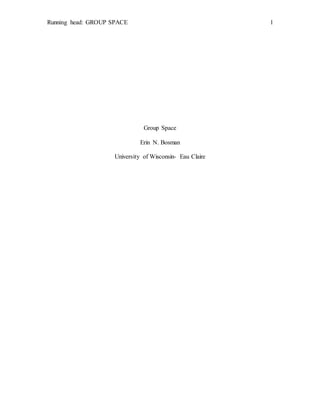Group Space
- 1. Running head: GROUP SPACE 1 Group Space Erin N. Bosman University of Wisconsin- Eau Claire
- 2. GROUP SPACE 2 Group Space When going out with friends or family, often times the group will claim a territory in some form. They will put out their personal items such as purses, sweatshirts, and etcetera to develop their group space within a public location. Group space is "a temporary spatial boundary that forms around interacting groups and serves as a barrier to unwanted intrusion by nonmembers" (Forsyth, 2014, pg.526). "Places that are typically occupied by a single person are individual-oriented places. A library carrel and an individualâs bedroom are examples of such environments. Aggregate- oriented places, those that are typically occupied by coacting individuals, are composed primarily of strangers or minimally related individuals who are performing the same kinds of actions parallel to but not in interaction with each other. Such environments include pedestrian malls, parking lots, and subway stations. Group-oriented places are those that are typically occupied by people who know and regularly interact with each other. Such places are usually focused on the activities of organized groups. (Ruback, Collins, Koon-Magnin, Ge, Bonkiewicz, & Lutz, 2013 pg.240)" The concept of group space is mostly seen in aggregate- oriented places and group-oriented places rather than individual-oriented places, and of those it is mostly seen in group-oriented places. In relation to aggregate-oriented places, the group space concept could be seen in a parking lot. For example, individuals often gather or carpool for events and will park in a specific area forming a group and using their vehicles as personal objects to define the group space. This could be seen tailgating before a sporting event, or at a company picnic. In relation to group-oriented places, the group space concept could be seen at a park. For example, my brother-in-law enjoys playing softball
- 3. GROUP SPACE 3 with his friends and often times during the summer, my sister and I will watch them play at a nearby park. We bring chairs, and coolers, and a blanket and claim our group space. Group space's can form in a variety of places and territorial settings. They are temporary spaces that form around interacting groups, often by claiming the space with personal objects. Group spaces can be seen being formed in various public locations such as parking lots, the beach, or a park.
- 4. GROUP SPACE 4 References Forsyth, D. (2014). Groups in Context. In Group dynamics (6th ed.). Belmont, California: Wadsworth. Ruback, R. B., Collins, R. T., Koon-Magnin, S., Ge, W., Bonkiewicz, L., & Lutz, C. E. (2013). People Transitioning Across Places: A Multimethod Investigation of How People Go to Football Games. Environment & Behavior, 45(2), 239-266. doi:10.1177/0013916511412589 Schiavo, R. S., Kobashi, K., Quinn, C., Sefscik, A., & (Lori) Synn, K. M. (1995). Territorial influences on the permeability of group spatial boundaries. The Journal Of Social Psychology, 135(1), 27-29. doi:10.1080/00224545.1995.9711398



